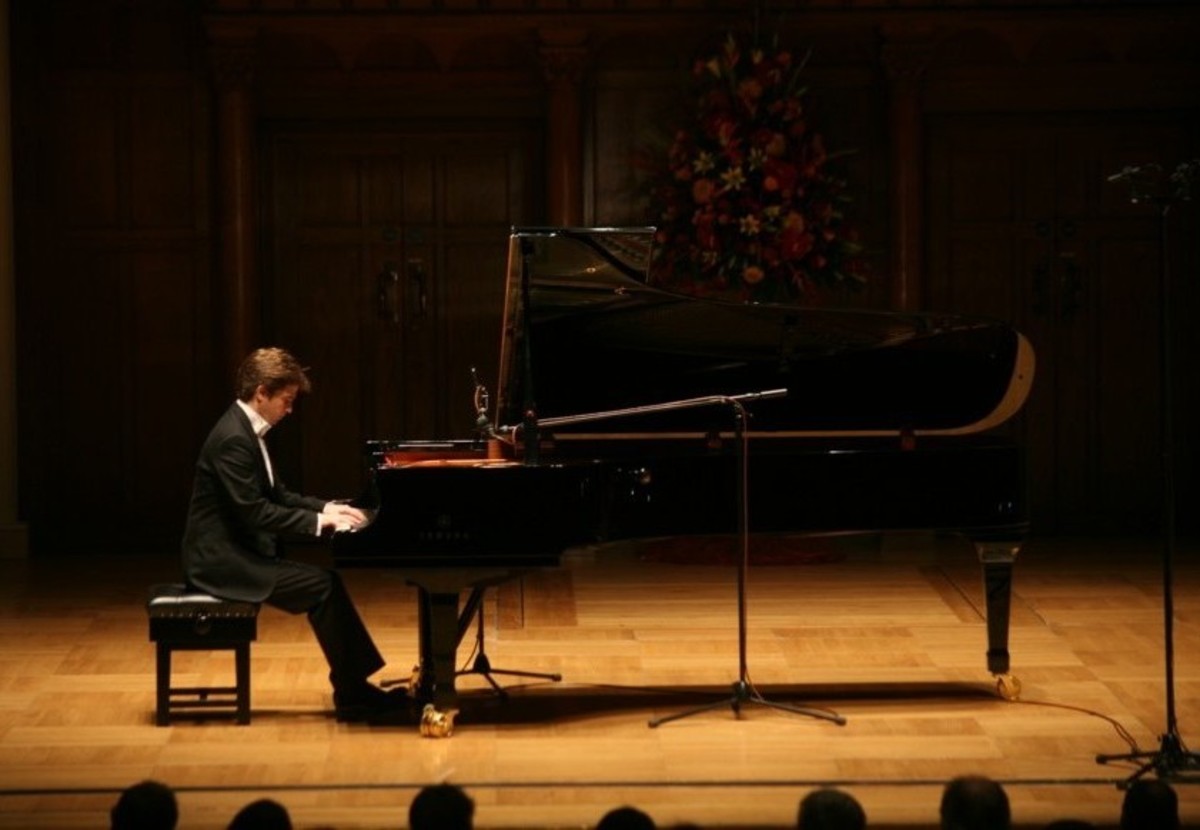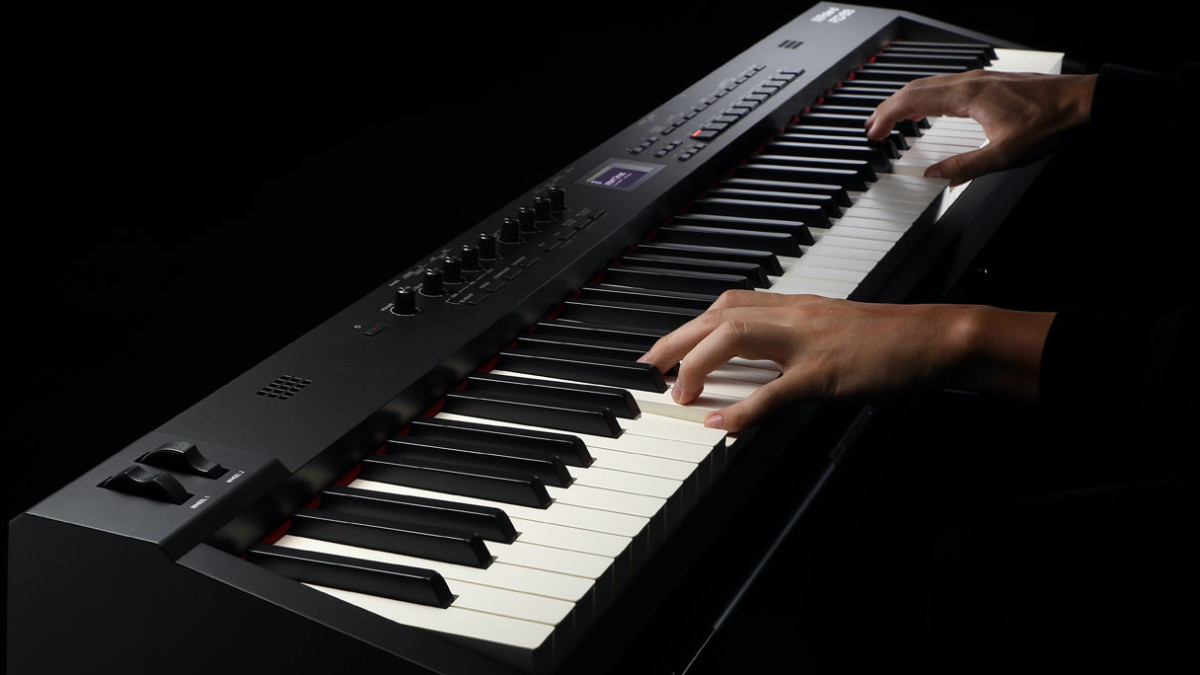Easy Piano Lesson for Learning Basic Jazz
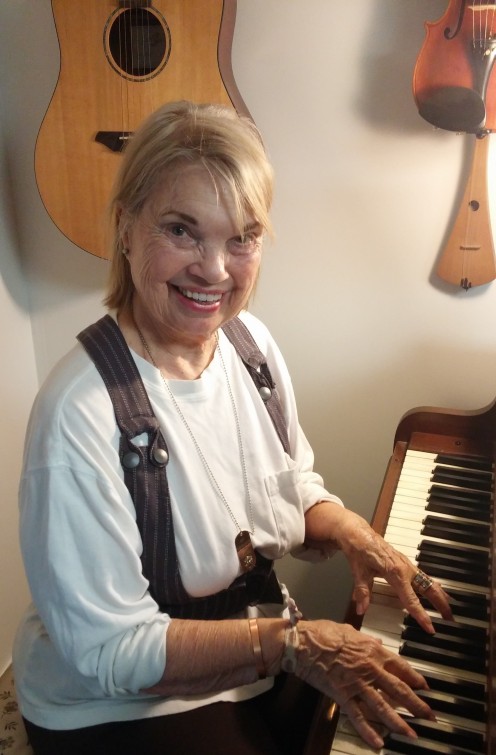
How To Play Simple Jazz Chords
If there's anything more enjoyable for a pianist than arranging music by creating his own style, I don't know what it is. Working with the late, great, jazz genius, Dave Brubeck, inspired me to do what I can to teach other pianists to reach out and give it a try.
One of the best and easiest ways to develop your piano style is with the use of simple jazz chords.
- Seated at the piano, pick out the notes to 'Mary had a little lamb.' Play it in the key of C Major, beginning on E with the right hand.
- Now add left-hand triads ( 3 note chords ). The only 2 chords you will play are the 1 and V7 which will be a C chord and a G7, root positions or inverted if you like.
- Play hands together a couple of times before continuing.
- Next, you will be playing the same melody, jazz style. This will be so much fun.
- Again, keeping it simple, let's add the 7th tone to the triads you've just played.
- Concentrating on just the left hand, play a CMaj7 chord in root position (CEGB.)
- Correct fingering for this chord is 5321. Play this chord solid, not broken.
- The next chord is a dm7 in root position (DFAC.)
- If you're a beginner, stop here and take time to practice forming these chords. Practice until you can play first the CMaj7 to the dm7 and back again. When this becomes automatic and easy, proceed to the next step which will show you how to play two popular jazz chords.
Simple Jazz Chords by Audrey Hunt
Chord
| Root
| Major Third
| Perfect Fifth
| Major Seventh
|
|---|---|---|---|---|
Cmaj7
| C
| E
| G
| B
|
Dm7
| D
| F natural
| A
| C natural
|
These are your two beginning jazz chords to be played with the left hand
Mary Had A Little Lamb (Simple Jazz, Classical and New Age Style) by Audrey Hunt
Playing Jazz Hands Together
Having fun? Want to learn more? Sure you do.
So let's begin by playing hands together.
For beginner's, begin by playing Mary Had A Little lamb adding the jazz chords in the left hand. Note: Play the right-hand melody one octave higher instead of the middle of the keyboard. Otherwise, the left and right hand will end up sharing middle C when playing some of the chords.
- Begin by playing the left-hand CMaj7 chord and the right-hand E together at the same time. You'll hear a popular jazz sound.
- Next - Hold the left-hand CMaj7 chord down while the right-hand plays D. Sustain the chord until the next step.
- Now you will step up one key and play the dm7 chord with the left hand. At the same time, the right-hand plays C.
- Hold down the dm7 chord with the left hand while the right-hand plays D.
- Bring the left hand back down 1 step and play the CMaj7 chord again. The right-hand plays E, E. E as the left-hand chord is sustained.
- With the left hand playing the dm7 chord, play D, D.D with the right hand. Hold the chord while you play the 3 D's.
- Continue on with the left hand playing a CMaj7 chord as the right-hand plays an E, G, G. Again, hold the left-hand chord until you complete the final G.
- Then the left hand will play another CMaj7 chord while the right-hand plays an E, D. Sustain the left-hand chord.
- Left hand now plays the dm7 chord as the right-hand plays a C, D.
- Play the CMaj7 chord with the right hand playing E, E, E, E. Be sure to hold the chord down.
- Left-hand plays the dm7 chord as the right-hand plays D, D, E, D.
- Then play the CMaj7 chord with the left hand to finish the song with the right hand playing C.
Blues Scale for the Piano by Audrey Hunt
The Blues Scale
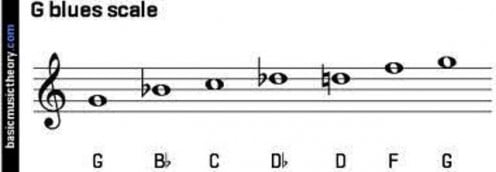
How To Play The Blues Scale
The blues scale can be heard in most piano genres from rock and jazz to, of course, the blues.
This scale is fun to play and experiment with, and a real buddy for learning to style your piano pieces. Here's how you build a blues scale.
The step pattern for this seditious little scale is 11/2-Whole-Half-Half-11/2-Whole.
- It has only seven notes
- It begins with one and one-half steps
- It has two half-steps in a row
The blues scale consists of 6 different notes. They are simply the 5 notes of the minor pentatonic scale plus one additional note.
The note added is the diminished 5th measured from the scale tonic( the first tone played - the home tone.). Here's an example:
Adding to the C minor pentatonic scale: C - Eb - F - G - Bb - C
When adding the diminished 5th - Gb, you're playing the C Blues scale: C - Eb - F - Gb - Bb - C
In relation to the major scale, the notes of the blues scale are: 1 - 3b - 4 - 5b - 5 - Bb - 1
The b3, b5 and b7 notes of the scale for C blues scale: Eb, Gb, and Bb are the so-called blue notes of the scale.
Warning - the blues scale can become addictive. Watch the video above as I play this scale, adding a little improvising of my own.
Blues Scales for the Keys of C - G - D - A - E
Play these notes first with the right hand, then use the left hand. Repeat these many times and soon they will be a piece-of-cake to play.
C - Eb - F - Gb - G - Bb - C
G - Bb - C - Db - D - F - G
D - F - G - Ab - A - C - D
A - C - D - Eb - E - G - A
E - G - A - Bb - B - D - E
Once you learn one or two of the above scales, you're ready to have fun and make your own music by improvising.
- Play the left-hand bassline while outlining chord tones with your right hand.
- Play the left-hand bass line against simple right-hand improvisation.
Quick Tips For Piano Stylings
Here they are. I'm sharing with you what has taken me a lifetime to learn. Make these tips a priority and the rest is all downhill.
- Know all major and minor scales like the back of your hand. Why? Because all music is built around scales. When you really know scales, you know musical form. Also, you find that you play piano music well - whether you're playing a Chopin Prelude or Country music, you've learned through scales pretty much what has been written. Your technique allows you the freedom to play without error.
- Practice playing all kinds of chords in all keys. Arrange them differently to give you that edge when improvising.
- Never rest on your laurels. This is the fastest way to slide backward and lose all the knowledge and practice you've put into your piano playing. You will never maintain a certain level of technique. You either go backward or forwards. Choose to continue going forward.
- Sit at the piano and just play. You must become one with the instrument.
- There is no wrong or right to finding your style of playing. There is also no limit.
Playing Piano Brings Joy to the Self and Others
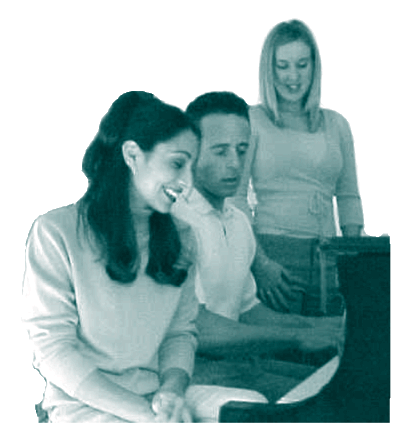
Finding Your Own Piano Style
You love to play the piano and you're quite proficient at it. You've had lessons, studied music theory, and sight-read well. You love to play all genres of music and even get compliments now and then. But something is missing as you play through some of your favorite songs. You're not sure what it is.
This is where I step in. As a long-time professional pianist on cruise lines and other venues, I would ask you the following questions:
- "Are you using your own style when you play?
- What do you experience as you engage yourself with each musical passage and what feelings come up for you?
- How involved in the music are you?"
Because you are the music maker make sure you are totally involved. It is you alone who is responsible for breathing life into each key you touch, each note you caress.
What then is style as it pertains to the pianist? Scan through the following list to get an idea about piano styles, then go to the very next section to learn how to play a simple, beginning 'jazz style.' You're gonna love what you learn here!
Listen to One of the Greatest Jazz Pianist of All Time.
A List of Piano Styles For The Pianist
There are endless combinations of piano styles which influence your own passion for playing a particular style:
- Classical - This style involves intense training and is basic for most other styles. It's through classical training that we learn about music theory. I was privileged to study Classical piano under my mentor and teacher, Peter Yazbeck at the University of California at Santa Barbara.
It's also important that a classical pianist is introduced to other styles early in their training. Classical artists usually have difficulty trying to learn other styles. For this reason, I train my classical pianists within the first year to adapt to and include a variety of other styles.
- Rhythm and Blues - Based on blues, jazz, and gospel, the strong rhythm claims the emphasis along with syncopation (placing the stress on other than the normal stressed beat.) Learning syncopation demands a certain balance using both hands. The great composer Ludwig Beethoven uses syncopation in many of his sonatas.
- Blues - Most blues songs are based on the 12 bar blues. When playing 1-1V - V chords of a scale, this pattern creates a foundation for melodies. Take time to learn the 12 bar blues pattern.
- Jazz - This style is impossible to describe as it covers such a broad spectrum of styles. Many styles borrow from jazz, including yours truly. I love playing jazz chords and modulating into other keys. Most improvisation uses jazz voicings and chords.
- Cocktail Piano - This style is mostly associated with Liberace, Eddy Duchin, Roger Williams and the like. I usually play cocktail style when I have a cruise ship gig or for private parties. This style specializes in difficult runs and flourishes. Show tunes are part of this style.
- Country and Western - Stems from earlier folk styles and uses the same roots as the blues. Country western uses simple chord progressions and is not as challenging to play.
- Ragtime - Ragtime uses syncopation in its melodies by placing melodic notes between the stressed beats of the rhythm. Everyone enjoys hearing this style of piano. Ragtime is often considered the first completely American genre, even predating jazz.
- Boogie-Woogie - This fun but difficult style is based on the blues. It is considered dance music and was popular in the '40s and '50s.
- Traditional Sacred Piano - This is a style heard mostly in church and is played by reading notation. These hymns allow less of a personal interpretation (although I have been known to do this often,)
- New Age Piano - This style is hard to define. It reached its peak in the '80s and '90s with the release of recordings of Enya and Keith Jarrett to mention a few. New Age Music relies on polychords (two different chords are played at once) and simple two-chord progressions. This technique is taken from earlier classical composers such as Stravinsky.
The #1 Tip To Styling Is Retentive Listening
Retentive listening is one of 14 different ways to listen. When listening to music in this way, your goal is to retain what is being heard. I can't stress the importance of this tip enough. Listen to other piano styles. This is the only way to discover the style you like best. Listen to a different genre of piano music every day. Even after you decide on a particular style, continue to listen to your favorite artist daily.
As you listen to music, make a mental note of exactly what runs and chords you would like to use in your own playing. Then play a simple melody like 'Mary Had a Little Lamb', 'Silent Night' or 'You Are My Sunshine' and begin building the chords and runs that appeal to you.
As you try different styles, don't get discouraged if you don't sound professional at once. Keep on trying and then try again. The very sounds that you memorize in your mind will begin to take form on the piano.
Also, listen to different artists playing the very same song. Define the differences, selecting what you'd like to play as you work toward developing your own style.
As a college teacher in the Music Theory and Piano Department, I made it a point to assign students musical listening exercises. I even went as far as to hold classes at the beach to teach rhythm and sound by listening to the waves.
I had one piano student who taught himself a mighty impressive jazz style just by duplicating jazz sounds he heard from different recordings of the jazz greats. And he didn't limit himself to all piano arrangements, he also listened to trumpet, saxophone, clarinet, the great upright bass and vocalists such as Dinah Washington, Ella Fitzgerald, Mel Torme and more.
Make listening to music a daily, consistent and joyful habit. It will bring you more enlightenment and more ideas than you ever could imagine.
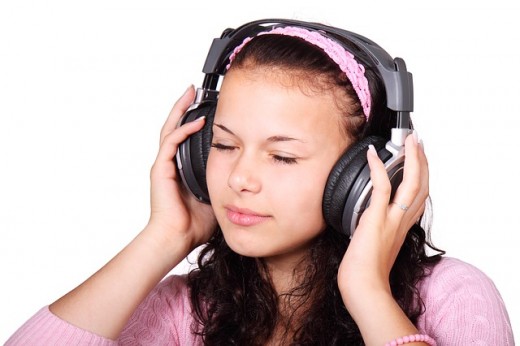
Just Sit at the Piano and Be
Author Mildred Portney Chase wrote a marvelous book. "Just Being at the Piano." This is one of my favorite passages:
"Just being - at the piano - egoless - is to each time seek to reach that place where the only things that exist are the sound and moving toward the sound. The music on the page that was outside of you is now within you and moves through you. You are a channel for the music and play from the center of your being. Everything that you have consciously learned, all of your knowledge, and the feelings evoked by that knowledge, emanate from within you."
There is a sense of oneness in which the heart of the musician and the heart of the composer meet, in which there is no room for self-conscious thought. You are at one with yourself and the act, and feel as if the playing has already happened and you are effortlessly releasing it.
The music is in your hands, in the air, in the room, the music is everywhere and the whole universe is contained in the experience of playing.
A Quick Review
Which of the following points will help you the most? Let's see how many you can remember:
- You, alone, are the master of your piano music. You are your own muse.
- Pay attention to your feelings for expressive playing.
- Your own style lives within you - release it now.
- Become familiar with all styles of music.
- Learn simple jazz chords to begin styling and improvising.
- Select easy melodies and add simple jazz chords.
- Listen every day to a variety of artists. Choose the style of piano you are passionate about.
- Become proficient with left-hand chords.
- Each day review all scales. This is how music is born - from scales.
- Never 'rest on your laurels.'
- Sit at the piano and just 'be.' Allow your music to flow through you to each piano key.
- There is no right or wrong to styling your music. And there is no limit.
I like to teach my piano angels (students) to "Play from the inside and your music will be found on the outside."
A Final Word
Developing your own piano style is fun. Once you get the hang of it you won't be able to stop experimenting.
Please don't worry about making mistakes. You can't. You are on a journey of discovery filled with surprises. All mistakes are simply stepping stones to progress. The more you practice, the easier it all fits together.
Try some or all of the suggestions listed. Experiment and even combine different styles. Whether you're a beginner or long-time pianist, you are the master and the muse of your own creation.
Be confident and above all, don't judge yourself. Enjoy the journey.
What is your favorite style of piano music?
Prayer is when you talk to God. Meditation is when you're listening. Playing the piano allows you to do both at the same time.
Kelsey Grammer quotes
© 2013 Audrey Hunt


